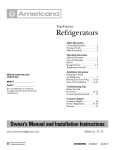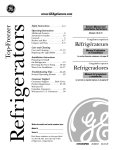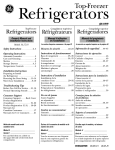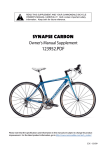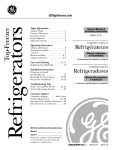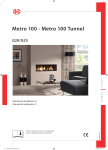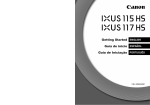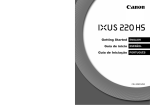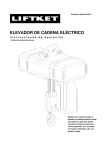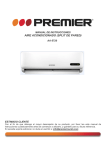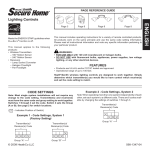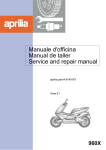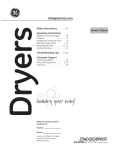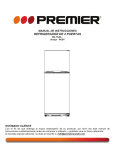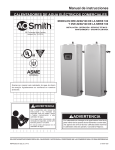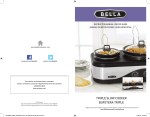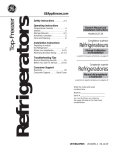Download Top-freezer - GE Appliances
Transcript
Top-freezer Refrigerators Safety Information Owner’s Manual Adapter Plugs . . . . . . . . . . . . . . . . . . 3 Connecting Electricity . . . . . . . . . . . 3 Extension Cords . . . . . . . . . . . . . . . . 2 Safety Precautions . . . . . . . . . . . . . . . 2 Models 15, 16, 17, 18 Operating Instructions Automatic Icemaker . . . . . . . . . . . . .8 Care and Cleaning . . . . . . . . . . . 9, 10 Shelves . . . . . . . . . . . . . . . . . . . . . . .5, 6 Storage Drawers . . . . . . . . . . . . . . .6, 7 Temperature Controls . . . . . . . . . . .4 Installation Instructions Preparing to Install the Refrigerator . . . . . . . . . . . . . . . . 11 Reversing the Door Swing . . . . 15–21 Water Line Installation . . . . . . 12–15 Troubleshooting Tips Before You Call for Service . . .22–24 Normal Operating Sounds . . . . . . .22 Write the model and serial numbers here: Model #__________________________ Serial # __________________________ You can find them on a label on the upper left side of the fresh food compartment. EXPORT 162D7737P004 49-60088 12-00 JR IMPORTANT SAFETY INFORMATION. READ ALL INSTRUCTIONS BEFORE USING. WARNING! Use this appliance only for its intended purpose as described in this Owner’s Manual. SAFETY PRECAUTIONS When using electrical appliances, basic safety precautions should be followed, including the following: ■ This refrigerator must be properly installed and located in accordance with the Installation Instructions before it is used. Also see the How To Connect Electricity section. ■ Do not attempt to stand on top of the refrigerator. Doing so may result in bodily injury or damage to the refrigerator. ■ Do not allow children to climb, stand or hang on the shelves in the refrigerator. They could damage the refrigerator and seriously injure themselves. ■ Do not allow children to play with the refrigerator or tamper with the controls. ■ Do not touch the cold surfaces in the freezer compartment when hands are damp or wet. Skin may stick to these extremely cold surfaces. ■ Do not store or use gasoline or other flammable vapors and liquids in the vicinity of this or any other appliance. ■ Keep fingers out of the “pinch point” areas; clearances between the doors and between the doors and cabinet are necessarily small. Be careful closing doors when children are in the area. ■ In refrigerators with automatic icemakers, avoid contact with the moving parts of the ejector mechanism, or with the heating element that releases the cubes. Do not place fingers or hands on the automatic icemaking mechanism while the refrigerator is plugged in. ■ Unplug the refrigerator before cleaning and making repairs. NOTE: We strongly recommend that any servicing be performed by a qualified individual. ■ Before replacing a burned-out light bulb, the refrigerator should be unplugged in order to avoid contact with a live wire filament. (A burned-out light bulb may break when being replaced.) NOTE: Turning the control to the 0 position does not remove power to the light circuit. ■ Do not refreeze frozen foods which have thawed completely. DANGER! RISK OF CHILD ENTRAPMENT PROPER DISPOSAL OF THE REFRIGERATOR Child entrapment and suffocation are not problems of the past. Junked or abandoned refrigerators are still dangerous…even if they will sit for “just a few days.” If you are getting rid of your old refrigerator, please follow the instructions below to help prevent accidents. Before You Throw Away Your Old Refrigerator or Freezer: ■ Take off the doors and discard separately. ■ Leave the shelves in place so that children may not easily climb inside. CFC Disposal Your old refrigerator may have a cooling system that used CFCs (chlorofluorocarbons). CFCs are believed to harm stratospheric ozone. If you are throwing away your old refrigerator, make sure the CFC refrigerant is removed for proper disposal by a qualified servicer. If you intentionally release this CFC refrigerant you can be subject to fines and imprisonment under provisions of environmental legislation. ■ If the refrigerator has a lock make it unusable. USE OF EXTENSION CORDS Because of potential safety hazards under certain conditions, we strongly recommend against the use of an extension cord. 2 However, if you must use an extension cord, it is absolutely necessary that it be a UL-listed, 3-wire grounding type appliance extension cord having a grounding type plug and outlet and that the electrical rating of the cord be 15 amperes (minimum) and 120 volts. WARNING! HOW TO CONNECT ELECTRICITY Do not, under any circumstances, cut or remove the third (ground) prong from the power cord. For personal safety, this appliance must be properly grounded. The power cord of this appliance is equipped with a 3-prong (grounding) plug which mates with a standard 3-prong (grounding) wall outlet to minimize the possibility of electric shock hazard from this appliance. IMPORTANT: The refitting of electric plugs and cables should be done by a qualified technician or service agent. In some countries the refitting of electric plugs and cables is only permitted when the work is completed by a qualified technician. Have the wall outlet and circuit checked by a qualified electrician to make sure the outlet is properly grounded. If the power supply cord becomes damaged, it must be replaced by a qualified service agent in order to avoid a safety hazard. Where an ungrounded wall outlet is encountered, it is your personal responsibility and obligation to have it replaced with a properly grounded 3-prong wall outlet. Never unplug your refrigerator by pulling on the power cord. Always grip plug firmly and pull straight out from the outlet. The refrigerator should always be plugged into its own individual electrical outlet. This provides the best performance and also Insure proper ground prevents overloading exists before using. house wiring circuits which could cause a fire hazard from overheated wires. Please refer to the rating plate on the refrigerator for the correct voltage, wattage and frequency. If the product plug does not fit your outlet, the product should be fitted with a new plug. Repair or replace immediately all power cords that have become frayed or otherwise damaged. Do not use a cord that shows cracks or abrasion damage along its length or at either end. When moving the refrigerator away from the wall, be careful not to roll over or damage the power cord. Mains Lead Replacement If the mains lead on your refrigerator needs replacing at any time, it must be replaced by a special lead which is obtainable from your local dealer. A charge will be made for the replacement of the mains lead if you have damaged the lead. USE OF ADAPTER PLUGS Because of potential safety hazards under certain conditions, we strongly recommend against the use of an adapter plug. However, if you must use an adapter, where local codes permit, a temporary connection may be made to a properly grounded 2-prong wall outlet by use of a UL-listed adapter available at most local hardware stores. The larger slot in the adapter must be aligned with the larger slot in the wall outlet to provide proper polarity in the connection of the power cord. When disconnecting the power cord from the adapter, always hold the adapter in place with one hand while pulling the power cord plug with the other hand. If this is not done, the adapter ground terminal is very likely to break with repeated use. If the adapter ground terminal breaks, DO NOT USE the refrigerator until a proper ground has been established. Attaching the adapter ground terminal to a wall outlet cover screw does not ground the appliance unless the cover screw is metal, and not insulated, and the wall outlet is grounded through the house wiring. You should have the circuit checked by a qualified electrician to make sure the outlet is properly grounded. READ AND FOLLOW THIS SAFETY INFORMATION CAREFULLY. SAVE THESE INSTRUCTIONS 3 About the temperature control dial. Turning the dial to 0 stops cooling in both compartments—fresh food and freezer. It does not shut off power to the refrigerator. Control Settings Temperature Control Dial The temperature control dial has nine settings plus 0. 1 is the warmest. 9 is the coldest. At first, set the dial at 5. Insert a coin into the slot in the middle of the dial and you can turn the dial to the setting that’s best suited to your needs. Allow 24 hours for the refrigerator to get cold. After using the refrigerator, adjust the dial if necessary. Anti-Condensation Switch (on some models) 1 4 0 If moisture develops on the ceiling of the fresh food compartment, turn the anticondensation switch to the 1 (on) position. Moisture is likely to appear when the air is humid—in the summer, in the early morning hours or in non-air conditioned rooms. Move to the 0 (OFF) position in less humid conditions. About the fresh food compartment shelves. Shelf supports at various levels allow you to custom-space your shelves. Not all features are on all models. Half-Width Shelves 2 Lift up and out 1 Tilt up One end of the shelf rests on a molded sidewall support; a bracket on the other end hooks into a track on the rear cabinet wall. NOTE: The shelf to the right of the track is designed to hook into the right-hand slot; the shelf to the left is designed to hook into the left-hand slot. To remove, lift the shelf up at front, then off the support and out of the track. To replace, select desired shelf height. With shelf front raised slightly, hook the bracket’s top lug into the track, then lower the shelf onto the support. Full-Width Shelves Some models have a steel wire sliding shelf, a stationary tempered glass shelf or two steel wire stationary shelves. These shelves can be moved to another place in the fresh food compartment. The full-width sliding shelf has stop-locks. When placed correctly on the shelf supports, the shelf will stop before coming completely out of the refrigerator and will not tilt when you place food on it or remove food from it. To remove the full-width shelves, lift the rear of the shelf and pull forward. To remove a full-width shelf when the fresh food compartment door cannot be opened fully, lift the rear of the shelf, pull forward and down, tilt the shelf and take it out. 5 About the frozen food compartment shelves. Some models have an ice-tray shelf and some have a full-width step shelf. Plug Supports Ice-Tray Shelf To remove the ice-tray shelf, lift the left side of the shelf off its supports, then pull the shelf to the left to free it of the plug supports. Pull the shelf to the right to free the pins from the holes in the cabinet wall. Step Shelf To remove the step shelf: 1 Lift left side of shelf slightly. shelf to the left to free its right ends 2 Move from holes in the cabinet wall. right side of shelf, move shelf to the 3 Lower right and take it out. To replace the step shelf: shelf tilted as shown, fit left ends of 1 With shelf into holes in cabinet wall. left side of shelf slightly, swing shelf up, 2 Lift fit right ends of shelf into holes in cabinet wall, and lower shelf into place. Ice Trays (on some models) Ice trays are designed to release ice cubes easily. Hold tray upside-down over a container and twist both ends to release cubes. About the storage drawers. Not all features are on all models. Fruit and Vegetable Drawers Excess water that may accumulate in the bottom of the drawers should be emptied and the drawers wiped dry. Snacks Drawer This drawer can be moved to the most useful location for your family’s needs. 6 For only one or two ice cubes, leave the tray right-side up, twist both ends slightly and remove desired number of cubes. Wash ice trays and storage bin in lukewarm water only. Do not put them in an automatic dishwasher. About storage drawer and cover removal. Not all features are on all models. Drawer and Cover Removal Drawers can be removed easily by grasping the sides and lifting up slightly while pulling drawers past the stop location. Full-Width Drawer with Plastic Cover To remove the cover, lift it off its supports, pull it forward, tilt it and take it out. Twin Drawers with Glass Cover To remove: 1 Remove the drawers. in, push the front of glass cover 2 Reach up, and at the same time, pull it forward as far as it will come. Tilt it and take it out. Avoid cleaning the cold glass cover with hot water because the extreme temperature difference may cause it to break. the drawer frame. (Always 3 Remove remove the glass cover before you take out the drawer frame.) Lift the frame off the supports at each side and back, pull it forward, tilt it and take it out. To replace: the frame until it rests on the 1 Lower supports at each side and back. the glass cover, pushing its rear 2 Replace edge firmly into the rear frame channel and gently lowering the front into place. 3 Replace the drawers. 7 About the automatic icemaker. (on some models) A newly-installed refrigerator may take 12 to 24 hours to begin making ice. Automatic Icemaker Power Switch Green Power Light Icemaker Feeler Arm The icemaker will produce seven cubes per cycle—approximately 100–130 cubes in a 24-hour period, depending on freezer compartment temperature, room temperature, number of door openings and other use conditions. If the refrigerator is operated before the water connection is made to the icemaker, set the power switch to OFF. When the refrigerator has been connected to the water supply, set the power switch to ON. The green power light will come on. The icemaker will fill with water when it cools to freezing. A newly installed refrigerator may take 12 to 24 hours to begin making ice cubes. When the bin fills to the level of the feeler arm, the icemaker will stop producing ice. It is normal for several cubes to be joined together. If ice is not used frequently, old ice cubes will become cloudy, taste stale and shrink. If ice cubes get stuck in the icemaker, the green power light will blink. To correct this, set the power switch to OFF and remove the cubes. Set the power switch to ON to restart the icemaker. NOTE: In homes with lower-than-average water pressure, you may hear the icemaker cycle multiple times when making one batch of ice. Throw away the first few batches of ice to allow the water line to clear. Be sure nothing interferes with the sweep of the feeler arm. Icemaker Accessory Kit If your refrigerator did not already come equipped with an automatic icemaker, an icemaker accessory kit is available at extra cost. 8 Check the back of the refrigerator for the specific icemaker kit needed for your model. Care and cleaning of the refrigerator. Cleaning the Outside The door handles and trim (on some models). Clean with a cloth dampened with soapy water. Dry with a soft cloth. Keep the outside clean. Wipe with a clean cloth lightly dampened with kitchen appliance wax or mild liquid dish detergent. Dry and polish with a clean, soft cloth. Do not wipe the refrigerator with a soiled dish cloth or wet towel. These may leave a residue that can erode the paint. Do not use scouring pads, powdered cleaners, bleach or cleaners containing bleach because these products can scratch and weaken the paint finish. Cleaning the Inside To help prevent odors, leave an open box of baking soda in the fresh food and freezer compartments. Unplug the refrigerator before cleaning. If this is not practical, wring excess moisture out of sponge or cloth when cleaning around switches, lights or controls. Avoid cleaning cold glass shelves (on some models) with hot water because the extreme temperature difference may cause them to break. Handle glass shelves carefully. Bumping tempered glass can cause it to shatter. Do not wash any plastic refrigerator parts in the dishwasher. Use warm water and baking soda solution— about a tablespoon (15 ml) of baking soda to a quart (1 liter) of water. This both cleans and neutralizes odors. Rinse and wipe dry. After cleaning the door gaskets, apply a thin layer of petroleum jelly to the door gaskets at the hinge side. This helps keep the gaskets from sticking and bending out of shape. Condenser Cleaning the condenser coils. There is no need for routine condenser cleaning in normal home operating environments. However, in environments that may be particularly dusty or greasy, the condenser should be cleaned periodically for efficient refrigerator operation. Light Bulb Replacement To clean the condenser, turn the temperature control dial to 0. Sweep away or vacuum up dust. For best results, use a brush specially designed for this purpose. It is available at most appliance parts stores. (on some models) A light bulb and socket are located at the top of the fresh food compartment opposite the temperature control panel. To replace the bulb, first unplug the refrigerator from its electrical outlet. Put your hand under the light shield and release the hook at the bulb end of the shield. (The light shield is on some models.) Squeeze to release the hook. 9 Care and cleaning of the refrigerator. Behind the Refrigerator Be careful when moving the refrigerator away from the wall. All types of floor coverings can be damaged, particularly cushioned coverings and those with embossed surfaces. Turn the leveling legs at each front corner of the refrigerator counterclockwise until the rollers support the refrigerator. Pull the refrigerator straight out and return it to position by pushing it straight in. Moving the refrigerator in a side direction may result in damage to the floor covering or refrigerator. When pushing the refrigerator back, make sure you don’t roll over the power cord or icemaker supply line (on some models). After rolling the refrigerator back into place, turn the legs clockwise until the legs again bear the weight of the refrigerator. Preparing for Vacation For long vacations or absences, remove food and unplug the refrigerator. Move the temperature control dial to the 0 position, and clean the interior with a baking soda solution of one tablespoon (15 ml) of baking soda to one quart (1 liter) of water. Leave the doors open. Set the icemaker power switch to OFF and shut off the water supply to the refrigerator. If the temperature can drop below freezing, have a qualified servicer drain the water supply system (on some models) to prevent serious property damage due to flooding. Preparing to Move Secure all loose items such as grille, shelves and drawers by taping them securely in place to prevent damage. 10 Be sure the refrigerator stays in an upright position during moving. Installation Instructions BEFORE YOU BEGIN Read these instructions completely and carefully. • IMPORTANT – Save these instructions for local inspector’s use. • • • • • • • IMPORTANT – Observe all governing codes and ordinances. Note to Installer – Be sure to leave these instructions with the Consumer. Note to Consumer – Keep these instructions for future reference. Skill level – Installation of this appliance requires basic mechanical skills. Completion time – Refrigerator Installation 15 minutes Reversing the Door Swing 1 hour Proper installation is the responsibility of the installer. Product failure due to improper installation is not covered under the Warranty. WATER SUPPLY TO THE ICEMAKER (on some models) If the refrigerator has an icemaker, it will have to be connected to a cold drinking water line. A water supply kit (containing copper tubing, shutoff valve, fittings and instructions) is available at extra cost from your dealer. Installation of the icemaker must be done by a qualified service technician. REFRIGERATOR LOCATION • Do not install the refrigerator where the temperature will go below 60°F (16°C) because it will not run often enough to maintain proper temperatures. • Install it on a floor strong enough to support it fully loaded. Refrigerator Models 15, 16, 17 and 18 DIMENSIONS Model 15 16 17 18 A* 61″ (155 cm) 64″ (163 cm) 67″ (170 cm) 67″ (170 cm) B 28″ (71 cm) 28″ (71 cm) 28″ (71 cm) 28″ (71 cm) C** 311/10″ (79 cm) 311/10″ (79 cm) 321/4″ (81 cm) 321/3″ (82 cm) D 547/10″ (139 cm) 547/10″ (139 cm) 56″ (142 cm) 563/8″ (143 cm) E 26″ (66 cm) 26″ (66 cm) 267/9″ (68 cm) 267/9″ (68 cm) * Height does not include hinge—Add 22 mm for hinge. ** Depth includes handle. A B E C D ROLLERS AND LEVELING LEGS Leveling legs near each front corner of the refrigerator are adjustable. They firmly position the refrigerator and prevent it from moving when the doors are opened. Leveling legs should be set so the front of the refrigerator is raised just enough that the doors close easily when opened about halfway. Turn the leveling legs clockwise to raise the refrigerator, counterclockwise to lower it. Rollers next to the leveling legs allow you to move the refrigerator away from the wall for cleaning. Turn the legs counterclockwise until the weight of the refrigerator is transferred from them to the rollers. After rolling the refrigerator back into place, turn the legs clockwise until the legs again bear the weight of the refrigerator. CLEARANCES Allow the following clearances for ease of installation, proper air circulation and plumbing and electrical connections. • Sides 3/4″ (19 mm) • Top 1″ (25 mm) • Back 1″ (25 mm) 11 Installation Instructions 1 INSTALLING THE WATER LINE BEFORE YOU BEGIN WHAT YOU WILL NEED (CONT.) This water line installation is not warranted by the refrigerator or icemaker manufacturer. Follow these instructions carefully to minimize the risk of expensive water damage. Water hammer (water banging in the pipes) in house plumbing can cause damage to refrigerator parts and lead to water leakage or flooding. Call a qualified plumber to correct water hammer before installing the water supply line to the refrigerator. To prevent burns and product damage, do not hook up the water line to the hot water line. If you use your refrigerator before connecting the water line, make sure the icemaker power switch is in the OFF position. • Copper tubing, 1/4″ outer diameter to connect the refrigerator to the water supply. Be sure both ends of the tubing are cut square. Do not use plastic tubing or plastic fittings because the water supply line is under pressure at all times. Certain types of plastic tubing may become brittle with age and crack, resulting in water leakage. Do not install the icemaker tubing in areas where temperatures fall below freezing. When using any electrical device (such as a power drill) during installation, be sure the device is insulated or wired in a manner to prevent the hazard of electric shock. All installations must be in accordance with local plumbing code requirements. • Two 1/4 ″ outer diameter compression nuts and 2 ferrules (sleeves)—to connect the copper tubing to the shutoff valve and the refrigerator water valve. Installation of the icemaker must be done by a qualified service technician. WARNING! water supply only. Connect to potable WHAT YOU WILL NEED To determine how much copper tubing you need: Measure the distance from the water valve on the back of the refrigerator to the water supply pipe. Then add 8 feet (244 cm). Be sure there is sufficient extra tubing [about 8 feet (244 cm) coiled into 3 turns of about 10 inches (25 cm) diameter] to allow the refrigerator to move out from the wall after installation. • A water supply kit (containing copper tubing, shutoff valve and fittings listed below) is available at extra cost from your local distributor. • A cold drinking water supply. The water pressure must be between 20 and 120 p.s.i. (1.4–8.1 bar). • Power drill. 12 • If your existing water line has a flared fitting at the end, you will need an adapter (available at plumbing supply stores) to connect the water line to the refrigerator OR you can cut off the flared fitting with a tube cutter and then use a compression fitting. • Shutoff valve to connect to the cold water line. The shutoff valve should have a water inlet with a minimum inside diameter of 5/32″ at the point of connection to the COLD WATER LINE. Saddle-type shutoff valves are included in many water supply kits. Before purchasing, make sure a saddle-type valve complies with your local plumbing codes. Installation Instructions Install the shutoff valve on the nearest frequently used drinking water line. 1 SHUT OFF THE MAIN WATER SUPPLY 4 FASTEN THE SHUTOFF VALVE Fasten the shutoff valve to the cold water pipe with the pipe clamp. Pipe Clamp Turn on the nearest faucet long enough to clear the line of water. 2 CHOOSE THE VALVE LOCATION Choose a location for the valve that is easily accessible. It is best to connect into the side of a vertical water pipe. When it is necessary to connect into a horizontal water pipe, make the connection to the top or side, rather than at the bottom, to avoid drawing off any sediment from the water pipe. Vertical Cold Water Pipe Saddle-Type Shutoff Valve 5 TIGHTEN THE PIPE CLAMP Tighten the clamp screws until the sealing washer begins to swell. NOTE: Do not overtighten or you may crush the copper tubing. Washer Pipe Clamp Inlet End Clamp Screw 3 DRILL THE HOLE FOR THE VALVE Drill a 1/4″ hole in the water pipe, using a sharp bit. Remove any burrs resulting from drilling the hole in the pipe. 6 ROUTE THE TUBING Route the copper tubing between the cold water line and the refrigerator. Route the tubing through a hole drilled in the wall or floor (behind the refrigerator or adjacent base cabinet) as close to the wall as possible. NOTE: Be sure there is sufficient extra tubing [about 8 feet (244 cm) coiled into 3 turns of about 10 ″ (25 cm) diameter] to allow the refrigerator to move out from the wall after installation. 13 Installation Instructions 1 INSTALLING THE WATER LINE 7 CONNECT THE TUBING TO THE VALVE Place the compression nut and ferrule (sleeve) onto the end of the tubing and connect it to the shutoff valve. (CONT.) 9 CONNECT THE TUBING TO THE REFRIGERATOR (CONT.) 9.1 Remove the access cover. Make sure the tubing is fully inserted into the valve. Tighten the compression nut securely. Saddle-Type Shutoff Valve Compression Nut 9.2 Remove the plastic flexible cap from the water valve. Packing Nut Outlet Valve Ferrule (sleeve) 8 FLUSH OUT THE TUBING Turn the main water supply on and flush out the tubing until the water is clear. Shut the water off at the water valve after about one quart (1 liter) of water has been flushed through the tubing. 9.3 Place the compression nut and ferrule (sleeve) onto the end of the tubing as shown. Insert the end of the copper tubing into the water valve connection as far as possible. While holding the tubing, tighten the fitting. Fasten the copper tubing into the clamp provided to hold it in a vertical position. You may need to pry open the clamp. Tubing Clamp 1/4″ Copper Tubing 1/4″ Compression Nut 9 CONNECT THE TUBING TO THE REFRIGERATOR NOTES: • Before making the connection to the refrigerator, be sure the refrigerator power cord is not plugged into the wall outlet. • We recommend installing a water filter if your water supply has sand or particles that could clog the screen of the refrigerator’s water valve. Install it in the water line near the refrigerator. 14 Ferrule (sleeve) Refrigerator Connection 9.4 Reattach the access cover. Installation Instructions 10 TURN THE WATER ON AT THE SHUTOFF VALVE Tighten any connections that leak. 12 START THE ICEMAKER Set the icemaker power switch to the ON position. The icemaker will not begin to operate until it reaches its operating temperature of 15°F (-9°C) or below. It will then begin operation automatically if the icemaker power switch is in the ON position. Power switch 11 PLUG IN THE REFRIGERATOR Arrange the coil of copper tubing so that it does not vibrate against the back of the refrigerator or against the wall. Push the refrigerator back to the wall. NOTE: In lower water pressure conditions, the water valve may turn on up to 3 times to deliver enough water to the icemaker. 2 REVERSING THE DOOR SWING IMPORTANT NOTES When reversing the door swing: • Read the instructions all the way through before starting. • Handle parts carefully to avoid scratching paint. • Set screws down by their related parts to avoid using them in the wrong places. • Provide a non-scratching work surface for the doors. IMPORTANT: Once you begin, do not move the cabinet until door-swing reversal is completed. These instructions are for changing the hinges from the right side to the left side—if you ever want to change the hinges back to the right side, follow these same instructions and reverse all references to left and right. TOOLS REQUIRED Phillips screwdriver Masking tape 5/16″ hex-head socket driver T20 or T25 Torxdriver, whichever your model requires Putty knife or thinblade screwdriver 5/16″ open-end wrench 15 Installation Instructions 2 REVERSING THE DOOR SWING 1 BEFORE YOU START 1.1 Unplug the refrigerator from its electrical outlet. (CONT.) 2 REMOVE THE FROZEN FOOD COMPARTMENT DOOR (CONT.) 2.2 With a 5/16″ hex-head socket driver, remove the screws that hold the top hinge to the cabinet. 1.2 Empty all door shelves, including the dairy compartment. 2.3 Lift the hinge (and the shim glued to it) straight up to free the hinge pin from the socket in the top of the door and set it aside, along with its screws. Top Hinge CAUTION: Do not let either door drop to the floor. To do so could damage the door stop. 2.4 Remove the tape and tilt the door away from the cabinet. Lift it off the center hinge pin. 2 REMOVE THE FROZEN FOOD COMPARTMENT DOOR 2.1 Tape the door shut with masking tape. 2.5 Set the door on a non-scratching surface with the outside up. 16 Installation Instructions 2 REMOVE THE FROZEN FOOD COMPARTMENT DOOR (CONT.) 2.6 Using a Torxdriver, transfer the 2 screws from the opposite side of the cabinet to the screw holes vacated by the top hinge removal. 3 REMOVE THE FRESH FOOD DOOR 3 REMOVE THE FRESH FOOD DOOR (CONT.) 3.4 Set the door outside-up on a non-scratching surface. 3.5 Using a Torxdriver, transfer the two screws from the opposite side of the cabinet to the screw holes vacated by the center hinge removal. 3.1 Tape the door shut with masking tape. 3.6 Transfer the washer (if your model has one) to the opposite side. 3.2 Using a 5/16″ hex-head socket screwdriver and a 5/16″ open-end wrench, remove the two screws holding the center hinge (and the shim glued to it) to the cabinet. Lift the center hinge to free its pin from the socket in the top of the door, and set hinge and screws aside. Be careful not to lose the center hinge spacer and washer. 3.7 Take one of the screws removed in step 2 and start it in the outermost screw hole on the opposite side. Do not drive it all the way down—leave enough space under the screw head for thickness of shim and bracket. 3.3 Remove the tape and tilt the door away from the cabinet. Lift the door from the pin in the bottom hinge bracket. (If the plastic washer sticks to the door bottom, put it back on the hinge.) 17 Installation Instructions 2 REVERSING THE DOOR SWING 4 REVERSING THE HARDWARE 4.1 Remove the base grille (if your refrigerator has one) by pulling it straight out. (CONT.) 5 REVERSING THE DOOR HANDLES 5.1 Transfer fresh food door handle 5.1.1 Remove the bottom cap by pushing it toward the bottom of the door, and remove the screw underneath. Remove the two screws holding the handle to the top of the door. Top 4.2 Using a Torxdriver, move the bottom hinge bracket (and shim glued to it) and plastic washer from the right side to the left side. Plastic Washer Hinge Bracket 5.1.2 Remove the handle. 4.3 Interchange hinge (and the shim glued to it) and screws at top right with screws at top left of cabinet. Do not tighten screws on hinge side at this time. 5.1.3 Remove the screws from the right edge of the door top and insert them into the handle screw holes on the opposite side. Screws for Handle Holes Installing the hinge on the left. Installing the hinge on the right. NOTES: • Some hinges have four holes. Which holes you use for installing the hinge depends on which side you install the hinge. • The outer edge of the hinge should be parallel to the edge of the case for correct installation. 18 Installation Instructions 5 REVERSING THE DOOR HANDLES (CONT.) 5.1 Transfer fresh food door handle (cont.) 5.1.4 With tape-tipped putty knife or thinblade screwdriver, pry out the plug button from the hinge hole on the left side of the door and insert it into the hole on the opposite side that was vacated by removal of the top hinge. 5.2 Transfer door stop (cont.) 5.2.2 Move any screws from the left end to the right end. Right Side Plug Button 5.3 Reinstalling the Fresh Food Door Handle 5.3.1 Attach the handle to the right side of the door with screws at the top and under the handle plug. 5.1.5 Pull the plug button from the front of the door and transfer it to the opposite side. Plug Button 5.3.2 Reinstall the handle plug. To reattach the handle on the opposite side. 5.2 Transfer door stop 5.2.1 Move the metal door stop from the right end to the left end. Use a Torxdriver. Door Stop Left Side 19 Installation Instructions 2 REVERSING THE DOOR SWING 5.4 Transfer Frozen Food Compartment Door Handle 5.4.1 Remove the screw holding the handle to the top of the door and the two screws holding the handle to the bottom of the door. Top TOP BOTTOM Bottom 5.4.2 Remove the handle. 5.4.3 Remove the screw from the right top edge of the door and insert it into the handle screw hole on the left side. 20 (CONT.) 5.4 Transfer Frozen Food Compartment Door Handle (cont.) 5.4.4 Transfer the door stop as shown on the preceding page. 5.4.5 Attach the handle to the right edge of the door with screws at top and bottom, using bottom holes vacated by removal of the door stop screws. Installation Instructions 6 REHANGING THE DOORS 6 REHANGING THE DOORS (CONT.) 6.1 Rehang the fresh food door 6.2 Rehang the frozen food compartment door 6.1.1 Lower the fresh food door onto the bottom hinge pin. Be sure the washer is in place on the pin. 6.2.1 Lower the freezer door onto the center hinge pin. Be sure the washer and spacer are in place on the pin. Hinge Pin Center Hinge Pin Plastic Washer Plastic Washer and Spacer 6.1.2 Insert the pin on the center hinge into the socket in the top of the door. Place the spacer, then the washer, on the hinge pin. NOTE: The center hinge must be turned over as shown when mounted on the left side. 6.2.2 Tilt the door toward the cabinet, lifting the top hinge so the pin fits into the socket on the top of the door. Hinge Pin Plastic Washer and Spacer 6.1.3 Tilt the door toward the cabinet. As the door is brought into position, slide the hinge under the head of the screw which earlier had been partly driven into the outermost hole. Insert the remaining screw, then tighten both screws securely. 6.2.3 Make sure the door is slightly above the top of the cabinet and the gap between the doors is even across the front. Tighten the top hinge screws. Do not overtighten these screws—tighten them until they are just snug, then turn them another one-half turn. 21 Normal operating sounds. Depending on the placement of the refrigerator in your kitchen, you may want to place a piece of rubber-backed carpet under the refrigerator to reduce noise. The fan circulating air inside the freezer which keeps the temperatures even. Boiling water or a gurgling noise. The flow of refrigerant through the freezer cooling coils. Sizzling, hissing or popping sound. Water dropping on the defrost heater during the defrost cycle. Cracking or popping sound. Cooling coils expanding and contracting during the defrosting cycle. Water dripping as it melts from the evaporator and flows to the drain pan during the defrost cycle. Icemaker (on some models) The icemaker water valve will buzz when the icemaker fills with water. If the power switch is in the ON position it will buzz even if it has not yet been hooked up to water. Keeping the power switch in the ON position before it is hooked up to water can damage the icemaker. To prevent this, move the power switch to the OFF position. This will stop the buzzing. The sound of cubes dropping into the bin and water running in pipes as icemaker refills. These sounds are normal and are due mostly to highly efficient operation. Before you call for service… Troubleshooting Tips Save time and money! Review the charts on the following pages first and you may not need to call for service. Problem Possible Causes What To Do Refrigerator does not operate Refrigerator in defrost cycle. • Wait about 30 minutes for defrost cycle to end. Temperature control dial in 0 position. • Move the temperature control dial to a temperature setting. Refrigerator is unplugged. • Push the plug completely into the outlet. The fuse is blown/circuit breaker is tripped. • Replace fuse or reset the breaker. Roller screws or leveling legs need adjusting. • See Rollers and Leveling Legs. Vibration or rattling (slight vibration is normal) 22 Before you call for service… Problem Possible Causes What To Do Motor operates for long periods or cycles on and off frequently. (Modern refrigerators with more storage space and a larger freezer require more operating time. They start and stop often to maintain even temperatures.) Normal when refrigerator is first plugged in. • Wait 24 hours for the refrigerator to completely cool down. Often occurs when large amounts of food are placed in refrigerator. • This is normal. Door left open. • Check to see if package is holding door open. Hot weather or frequent door openings. • This is normal. Temperature control dial set at the coldest setting. • See About the temperature control dial. Grille and condenser need cleaning. • See Care and cleaning. Temperature control dial not set cold enough. • See About the temperature control dial. Warm weather or frequent door openings. • Set the temperature control dial one step colder. See About the temperature control dial. Door left open. • Check to see if package is holding door open. Package blocking air duct in freezer compartment. • Check to see if package is blocking air duct in freezer compartment. Frost or ice crystals on frozen food (frost within package is normal) Door left open. • Check to see if package is holding door open. Automatic icemaker does not work (on some models) Icemaker power switch in the OFF position. •Move the switch to the ON position. •Cubes may have fused to the side of the mold. Move the switch to the OFF position, then remove the cubes. Water supply turned off or not connected. •See Installing the water line. Freezer compartment too warm. •Wait 24 hours for the refrigerator to completely cool down. Piled up cubes in the storage bin cause the icemaker to shut off. •Level cubes by hand. Fresh food or freezer compartment too warm Too frequent or too long door openings. Cubes too small Water shutoff valve connecting •Call the plumber to clear the valve. refrigerator to water line may be clogged. Slow ice cube freezing Door left open. •Check to see if package is holding door open. Temperature control dial not set cold enough. •See About the temperature control dial. Ice storage bin needs cleaning. •Empty and wash bin. Discard old cubes. Food transmitting odor/taste to ice cubes. •Wrap foods well. Interior of refrigerator needs cleaning. •See Care and cleaning. Ice cubes have odor/taste 23 Before you call for service… Troubleshooting Tips Problem Possible Causes What To Do Moisture forms on cabinet surface between the doors Not unusual during periods of high humidity. •Wipe surface dry and reset temperature control dial one setting colder. Moisture collects inside (in humid weather, air carries moisture into refrigerator when doors are opened) Too frequent or too long door openings. Refrigerator has odor Foods transmitting odor to refrigerator. • Foods with strong odors should be tightly wrapped. • Keep an open box of baking soda in the refrigerator; replace every three months. Interior needs cleaning. • See Care and cleaning. 24 con congelador en la parte superior Refrigeradores Información de seguridad Cables de extensión . . . . . . . . . . . . . 2 Cómo conectar la electricidad . . . . 3 Enchufes adaptadores . . . . . . . . . . . 3 Precauciones de seguridad . . . . . . . 2 Manual del propietario Modelos 15, 16, 17, 18 Instrucciones de operación Controles de la temperatura . . . . . .4 Cuidado y limpieza . . . . . . . . . . . 9, 10 Estantes . . . . . . . . . . . . . . . . . . . . . .5, 6 Gavetas de almacenamiento . . . .6, 7 Máquina para hielo automática . . . .8 Instrucciones para la instalación Cómo invertir el vaivén de la puerta . . . . . . . . . . . . . . . . .15–21 Cómo preparar la instalación del refrigerador . . . . . . . . . . . . . . . .11 Instalación de la línea del agua . . . . . . . . . . . . . . . . . . . 12–15 Consejos para la solución de averías Antes de llamar a solicitar servicio . . . . . . . . . . . . .22–24 Sonidos normales de operación . .22 Escriba el modelo y número de serie aquí: Modelo # _______________________ Número de serie # ________________ Los puede encontrar en una etiqueta en el lado superior derecho del compartimiento de alimentos frescos. EXPORTATION 162D7737P004 49-60088 12-00 JR IMPORTANTE INFORMACIÓN DE SEGURIDAD. LEA TODAS LAS INSTRUCCIONES ANTES DEL USO. ¡ADVERTENCIA! Use este aparato sólo para el propósito establecido como se describe en este Manual del propietario. PRECAUCIONES DE SEGURIDAD Al usar aparatos eléctricos, se deberán seguir precauciones básicas de seguridad, incluyendo las siguientes: ■ Este refrigerador debe instalarse correctamente y ubicarse de acuerdo con las Instrucciones para la instalación antes de su uso. También consulte la sección Cómo conectar la electricidad. ■ No intente pararse sobre el refrigerador. Hacerlo puede resultar en daños físicos o daños al refrigerador. ■ No permita que los niños se suban, se paren o se cuelguen de los estantes del refrigerador. Podrían dañar el refrigerador y sufrir un serio accidente. ■ No permita que los niños jueguen con el refrigerador o con los controles. ■ No toque las superficies frías en el compartimiento del congelador con las manos húmedas o mojadas. La piel se podría pegar a estas superficies extremadamente frías. ■ No almacene ni use gasolina ni otros vapores inflamables alrededor de éste u otro aparato. ■ Mantenga los dedos alejados de las áreas estrechas; el espacio entre las puertas y entre éstas y los gabinetes es muy pequeño. Tenga cuidado al cerrar las puertas cuando haya niños en el área. ■ En refrigeradores con máquina automática de hielos, evite el contacto con las partes en movimiento del mecanismo expulsor, o con el elemento de calefacción que expulsa los cubos. No coloque los dedos o las manos en el mecanismo automático de la máquina de hielo mientras el refrigerador esté conectado. ■ Desconecte el refrigerador antes de limpiarlo y hacer reparaciones. NOTA: Recomendados fuertemente que cualquier servicio sea realizado por un individuo calificado. ■ Antes de reponer un bombillo fundido, usted debe desconectar el refrigerador para evitar el contacto con un filamento de cable encendido. (Es posible que un bombillo fundido se rompa mientras se reemplaza). NOTA: Bajar el control a la posición 0 no elimina la corriente del circuito de la luz. ■ No vuelva a congelar alimentos que han sido descongelados por completo. ¡PELIGRO! RIESGO DE ENCIERRO DE NIÑOS DESECHE EL REFRIGERADOR CORRECTAMENTE El encierro o sofocación de niños no es un problema del pasado. Los refrigeradores desechados o abandonados son todavía peligros, incluso si sólo van a permanecer “unos pocos días”. Si va a desechar su refrigerador, por favor siga las siguientes instrucciones para ayudar a evitar accidentes. ■ Si el refrigerador tiene una llave, póngala en uso. Antes de desechar su viejo refrigerador o congelador: Si está desechando su antiguo refrigerador, asegúrese de retirar el refrigerante CFC para un desecho adecuado por parte de un individuo calificado. Si desecha accidentalmente este refrigerante CFC, puede estar sujeto a multas y prisión según las disposiciones de la legislación ambiental. ■ Retire las puertas y deséchelas de forma separada. ■Deje los estantes en su lugar de manera que los niños no puedan subir fácilmente. Desecho de los CFC Es posible que su antiguo refrigerador tenga un sistema de enfriamiento que usaba CFC (clorofluorocarburos). Se cree que los CFC dañan el ozono estratosférico. USO DE CABLES DE EXTENSIÓN Debido a peligros potenciales de seguridad bajo ciertas condiciones, nos oponemos al uso de cables de extensión. 2 Sin embargo, si debe usar un cable de extensión, es absolutamente necesario que sea un tipo de cable de extensión para aparatos con conexión a tierra de tres cables, que esté en la lista de UL, que tenga un enchufe de tipo conexión a tierra y salida y que el grado eléctrico del cable sea de 15 amperios (mínimo) y 120 voltios. ¡ADVERTENCIA! CÓMO CONECTAR LA ELECTRICIDAD Bajo ninguna circunstancia corte ni retire la tercera pata (conexión a tierra) del cable de electricidad. Por seguridad personal, este aparato debe estar correctamente conectado a tierra. El cable eléctrico de este aparato está provisto de un enchufe de tres patas (conexión a tierra) que encaja en un tomacorriente estándar de 3 orificios (conexión a tierra) para minimizar la posibilidad de peligro de una descarga eléctrica. IMPORTANTE: El ajuste de enchufes eléctricos y cables lo debe realizar un técnico calificado o un agente de servicios. En algunos países el ajuste de enchufes y cables eléctricos sólo está permitido cuando el trabajo es llevado a cabo por un técnico calificado. Haga que el tomacorriente de la pared y el circuito sean revisados por un electricista calificado para asegurar que el tomacorriente tiene la conexión a tierra apropiada. Si el cable del suministro de energía se daña, debe ser repuesto por un agente de servicio calificado con el fin de evitar peligros de seguridad. Cuando haya un tomacorriente sin conexión a tierra, es su responsabilidad y obligación personales reemplazarlo con un tomacorriente adecuado de tres orificios. El refrigerador deberá siempre estar conectado en su propio tomacorriente eléctrico individual. Esto ofrece el mejor desempeño y también evita sobrecargar Asegúrese de que exista una conexión los circuitos eléctricos de la a tierra apropiada casa que podrían causar un antes del uso. incendio a partir de los cables recalentados. Por favor consulte la placa de clasificación en el refrigerador para el voltaje, vatiaje y frecuencia adecuados. Si el enchufe del producto no encaja en su tomacorriente, el producto deberá ser provisto de un nuevo enchufe. Nunca desconecte su refrigerador halando el cable eléctrico. Siempre tome el enchufe firmemente y hálelo directamente del tomacorriente. Repare o reemplace de inmediato todos los cables eléctricos que se hayan desgastado o dañado. No use un cable que tenga grietas o daños de abrasión en su longitud o en cualquier extremo. Al retirar el refrigerador de la pared, tenga cuidado de no enrollar o dañar el cable eléctrico. Reposición del terminal Si el terminal de su refrigerador necesita reposición en cualquier momento, debe ser reemplazado por un terminal especial que lo puede obtener de su proveedor local. Se hará un cargo por la reposición del terminal si se ha estropeado. USO DE ENCHUFES ADAPTADORES Debido a peligros potenciales de seguridad bajo ciertas condiciones, nos oponemos al uso de un enchufe adaptador. Sin embargo, si debe usar un adaptador, donde los códigos locales lo permitan, se puede hacer una conexión temporal a un tomacorriente de dos patas con el uso de un adaptador en la lista de UL, disponible en la mayoría de las ferreterías. El orificio más grande en el adaptador deberá alinearse con el orificio más grande en el tomacorriente para brindar la polaridad adecuada en la conexión del cable eléctrico. Al desconectar el cable eléctrico del adaptador, siempre sostenga el adaptador en su lugar con una mano, mientras hala el enchufe del cable eléctrico con la otra. Si no hace esto, es probable que el terminal a tierra del adaptador se rompa con el uso repetido. Si el terminal a tierra del adaptador se rompe, NO USE el refrigerador hasta que se haya establecido una conexión a tierra adecuada. Unir el terminal a tierra del adaptador a un tornillo de la tapa de un tomacorriente no equivale a una conexión a tierra, a menos que el tornillo de la tapa sea metálico, y no esté aislado, y el tomacorriente tenga conexión a tierra por medio del cableado de la casa. Deberá hacer que un electricista calificado revise si el tomacorriente está correctamente conectado a tierra. LEA Y SIGA CUIDADOSAMENTE ESTA INFORMACIÓN DE SEGURIDAD. CONSERVE ESTAS INSTRUCCIONES 3 Sobre el disco de control de la temperatura. Girar el disco a 0 descontinúa el enfriamiento en ambos compartimientos: alimentos frescos y congelador. No apaga la corriente hacia el refrigerador. Niveles del control Disco de control de la temperatura El disco de control de la temperatura tiene nueve niveles más 0. 1 es el más caliente, 9 es el más frío. Al inicio, fije el disco en 5. Inserte una moneda en el orificio en el centro del disco y podrá girar el disco al nivel que mejor se adapte a sus necesidades. Espere 24 horas para que el refrigerador se enfríe. Después de usar el refrigerador, ajuste el disco si es necesario. Interruptor de anti-condensación (en algunos modelos) 1 4 0 Si se crea humedad en el techo del compartimiento de alimentos frescos, gire el interruptor de anti-condensación a la posición de encendido (1). La humedad tiende a aparecer cuando el aire es húmedo, en el verano, en las horas de la mañana o en salones sin aire acondicionado. Muévalo a la posición de apagado (0) en condiciones menos húmedas. Sobre los estantes de los compartimientos de alimentos frescos. Los estantes se apoyan en varios niveles permitiéndole adaptarlos según sus necesidades. No todas las características están presentes en todos los modelos. Estantes de media extensión 2 Levante y retire 1 Inclínelo Un extremo del estante se apoya en un soporte moldeado hacia el lado de la pared; un gancho en el otro extremo se encaja en un carril en la pared posterior del gabinete. NOTA: El estante hacia la derecha del carril ha sido diseñado para encajar en el orificio de la derecha; el estante hacia la izquierda ha sido diseñado para encajar en el orificio izquierdo. Para retirarlo, levante el estante hacia el frente, luego fuera del soporte y hacia fuera del carril. Para reemplazarlo, seleccione la altura deseada del estante. Con el frente del estante levantado ligeramente, encaje la lengüeta superior del gancho en el carril, luego baje el estante al soporte. Estantes de extensión completa Algunos modelos tienen un estante deslizante metálico en acero, un estante de vidrio templado estacionario o dos estantes estacionarios metálicos en acero. Estos estantes se pueden mover hacia otra parte en el compartimiento de alimentos frescos. El estante deslizante de extensión completa tiene seguros de freno. Cuando se colocan correctamente en los soportes del estante, el estante parará antes de salirse completamente del refrigerador y no se inclinará cuando haya colocado o retirado alimentos de éste. Para retirar los estantes de extensión completa, levante la parte posterior del estante y hale. Para retirar un estante de extensión completa cuando la puerta del compartimiento de alimentos frescos no se pueda abrir completamente, levante la parte posterior del estante, hale hacia delante y luego hacia abajo, incline el estante y sáquelo. 5 Sobre los estantes del compartimiento de alimentos frescos. Algunos modelos tienen un estante de bandeja para hielos y otros tienen un estante de escalón de extensión completa. Pared del gabinete Estante de la bandeja de hielos Para retirar el estante de la bandeja de hielos, levante el lado izquierdo de la bandeja de sus soportes, luego hale el estante hacia la izquierda para liberarlo de los soportes de tapón. Hale el estante hacia la derecha para liberar los pasadores de los orificios en la pared del gabinete. Estante de escalón Para retirar el estante de escalón: ligeramente el costado izquierdo 1 Levante del estante. el estante hacia la izquierda para 2 Mueva liberar los extremos de la derecha de los orificios en la pared del gabinete. Baje el lado derecho del estante, mueva el estante hacia la derecha y retírelo. Para reponer el estante de escalón: Con el estante inclinado como se muestra, encaje los extremos de la izquierda del estante en los orificios en la pared del gabinete. 3 1 levante el lado izquierdo del 2 Ligeramente estante, voltee el estante hacia arriba, encaje los extremos del estante en los orificios en la pared del gabinete y baje el estante a su lugar. Bandejas de hielo (en algunos modelos) Las bandejas de hielo están diseñadas para liberar cubos de hielo fácilmente. Sostenga la bandeja hacia abajo sobre un contenedor y gire ambos extremos para liberar los cubos. Sobre las gavetas de almacenamiento. No todas las características están en todos los modelos. Gavetas para frutas y vegetales El exceso de agua que pueda acumularse al fondo de las gavetas debe retirarse y se deben limpiar las gavetas. Gaveta de servicio La gaveta de servicio puede colocarse en la ubicación más útil dependiendo de las necesidades de su familia. 6 Para uno o dos cubos de hielo únicamente, deje la bandeja hacia arriba, gire ambos extremos ligeramente y retire el número deseado de hielos. Lave las bandejas de hielo y el recipiente de almacenamiento en agua tibia únicamente. No las ponga en la lavadora de platos. Sobre cómo retirar la gaveta de almacenamiento y la cubierta. No todas las características están presentes en todos los modelos. Remoción de la gaveta y cubierta Las gavetas pueden retirarse fácilmente tomándolas de los lados y levantando ligeramente mientras se halan las gavetas pasando el punto de freno. Gavetas de extensión completa con cubierta plástica Para retirar la cubierta, levántela de sus soportes, hale hacia el frente, inclínela y sáquela. Gavetas idénticas con cubierta de vidrio Para retirarlas: 1 Retire las gavetas. la mano, empuje el frente de 2 Introduzca la cubierta de vidrio hacia arriba, y al mismo tiempo, hálela hacia delante lo más que pueda. Inclínela y sáquela. Evite limpiar la cubierta de vidrio fría con agua caliente ya que por la diferencia de temperaturas extremas podría romperse. la estructura de la gaveta. 3 Retire (Siempre retire la cubierta de vidrio antes de sacar la estructura de la gaveta). Levante la estructura de los soportes en cada lado y atrás, hálela hacia delante, inclínela y sáquela. Para reemplazarla: la estructura hasta que descanse en 1 Baje los soportes en cada lado y atrás. la cubierta de vidrio, 2 Reemplace empujando su borde trasero firmemente hacia el canal de la estructura posterior y suavemente bajando el frente a su lugar. 3 Reemplace las gavetas. 7 Sobre la máquina de hielo automática. (en algunos modelos) Un refrigerador recientemente instalado puede tomar entre 12 y 24 horas para empezar a hacer hielo. Interruptor de corriente Luz verde de la corriente Máquina de hielo automática Máquina de hielo Brazo indicador La máquina de hielo producirá siete cubos por ciclo, aproximadamente entre 100 y 130 cubos en un período de 24 horas, dependiendo de la temperatura del compartimiento del congelador, la temperatura del cuarto, el número de veces que se abre la puerta y otras condiciones de uso. Asegúrese de que nada interfiera con el movimiento del brazo indicador. Si el refrigerador se opera antes de hacer la conexión del agua hacia la máquina de hielo, fije el interruptor de corriente en la posición de apagado (OFF). Si el hielo no se usa con frecuencia, los cubos de hielo viejo se volverán turbios, con sabor rancio y se encogerán. Cuando se haya conectado el refrigerador al suministro de agua, fije el interruptor de corriente en la posición de encendido (ON). Se enciende la luz verde. La máquina de hielo se llenará de agua cuando se enfríe hasta congelarse. Un refrigerador recién instalado se puede tomar entre 12 y 24 horas para empezar a hacer cubos de hielo. Deseche los primeros cubos de hielo para permitir que la línea del agua se limpie. Cuando el contenedor se llene al nivel del brazo indicador, la máquina de hielo dejará de producir hielos. Es normal que varios cubos de hielo se junten. Si los cubos de hielo se atascan en la máquina de hielo, la luz verde se volverá intermitente. Para corregir esto, ponga el interruptor de corriente en la posición de apagado (OFF) y retire los cubos. Regrese el interruptor de corriente a la posición de encendido (ON) para reiniciar la máquina de hielo. NOTA: En hogares con presión de agua inferior a la promedio, es posible que escuche el ciclo de la máquina de hielo varias veces al hacer un lote de hielo. Kit de accesorios de la máquina de hielo Si su refrigerador no viene ya equipado con una máquina de hielo automática, existe un kit accesorio para la máquina de hielo que está disponible por un costo adicional. 8 Revise en la parte posterior del refrigerador en busca del kit para la máquina de hielo específica que necesita para su modelo. Cuidado y limpieza del refrigerador. Limpieza exterior Las manijas de la puerta y accesorio (en algunos modelos). Limpie con un paño humedecido con agua jabonosa. Seque con un paño seco. Mantenga el exterior limpio. Límpielo con un paño ligeramente humedecido con cera de cocina para electrodomésticos o detergente líquido suave para platos. Seque y brille con un paño limpio y seco. No limpie el refrigerador con un paño sucio para platos o con una toalla mojada. Estos pueden dejar residuos y pueden erosionar la pintura. No use almohadillas de restregar, limpiadores en polvo, blanqueadores o limpiadores que contengan blanqueadores ya que estos productos pueden raspar y debilitar el acabado de pintura. Limpieza interior Para ayudar a evitar olores, deje una caja abierta de bicarbonato en los compartimientos de alimentos frescos y en el congelador. Desconecte el refrigerador antes de limpiarlo. Si esto no es práctico, escurra la humedad excesiva con una esponja o paño al limpiar alrededor de los interruptores, luces o controles. Evite limpiar los estantes de vidrio fríos (en algunos modelos) con agua caliente ya que la diferencia de las temperaturas extremas puede causar que se quiebren. Manipule los estantes de vidrio con cuidado. Golpear el vidrio templado puede causar que se quiebre. No lave ninguna parte plástica del refrigerador en la lavadora de platos. Use una solución de agua tibia y bicarbonato — una cucharada (15 ml) de bicarbonato para un cuarto (1 litro) de agua. Esto limpia y neutraliza los olores. Enjuague y seque. Después de limpiar las juntas de las puertas, aplique una capa delgada de petrolato en las juntas de las puertas en el lado de las bisagras. Esto ayuda a evitar que las juntas se peguen y desformen. Condensador Limpieza de los espirales del condensador. No hay necesidad de una limpieza de rutina del condensador en ambientes de operación de hogares normales. Sin embargo, en ambientes que puedan ser particularmente polvorientos o grasosos, el condensador debe limpiarse periódicamente para una operación eficiente del refrigerador. Reposición de la bombilla Para limpiar el condensador, gire el disco de control de la temperatura a 0. Barra o aspire el polvo. Para mejores resultados, use un cepillo especialmente diseñado con este propósito, el cual está disponible en la mayoría de tiendas de repuestos para aparatos. (en algunos modelos) En la parte superior del compartimiento de alimentos frescos, opuesto al panel de control de la temperatura se encuentran una bombilla y una roseta. Para reponer la bombilla, primero desconecte el refrigerador de su tomacorriente. Ponga su mano debajo del protector de la luz y libere el gancho en el extremo de la bombilla del protector. (El protector de la luz está presente en algunos modelos). Apriete para liberar el gancho. 9 Cuidado y limpieza del refrigerador. Detrás del refrigerador Tenga cuidado al mover el refrigerador lejos de la pared. Todos los tipos de cubiertas de piso se pueden dañar, particularmente las cubiertas acojinadas y aquellas con superficies con diseños en relieve. Gire las patas niveladoras en cada esquina frontal del refrigerador en el sentido de las manecillas del reloj hasta que los rodillos soporten al refrigerador. Hale el refrigerador en línea recta y regréselo a su posición empujándolo de la misma forma. Mover el refrigerador en una dirección lateral puede resultar en daños a la superficie del piso o al refrigerador. Cuando empuje de nuevo el refrigerador, asegúrese de no pisar el cable eléctrico o la línea de suministro a la máquina de hielo (en algunos modelos). Después de empujar el refrigerador de nuevo hacia su lugar, gire las patas en el sentido de las manecillas del reloj hasta que las patas de nuevo sostengan el peso del refrigerador. Cómo prepararse para las vacaciones Para vacaciones o ausencias prolongadas, retire los alimentos y desconecte el refrigerador. Gire el disco de control de la temperatura hacia la posición 0, y limpie el interior con una solución de una cucharada de bicarbonato (15 ml) y un cuarto (1 litro) de agua. Deje las puertas abiertas. Fije el interruptor eléctrico en la posición de apagado (OFF) y cierre el suministro del agua hacia el refrigerador. Si la temperatura puede caer por debajo del punto de congelamiento, haga que una persona calificada drene el sistema del suministro de agua (en algunos modelos) para evitar serios daños a la propiedad causados por inundaciones. Cómo prepararse para trasladarse Asegure todos los artículos sueltos como la rejilla, los estantes y cajones pegándolos con cinta en su lugar para evitar daños. 10 Asegúrese de que el refrigerador permanece en una posición vertical durante el traslado. Instrucciones para la instalación ANTES DE INICIAR Lea estas instrucciones completa y cuidadosamente. IMPORTANTE – Guarde estas instrucciones para uso del inspector local. • IMPORTANTE – Observe todos los • códigos y órdenes legales. • Nota al instalador – Asegúrese de dejar estas • Nota al consumidor – Conserve estas instrucciones con el consumidor. instrucciones para referencia futura. • Nivel de destreza – La instalación de este aparato requiere de destrezas mecánicas básicas. • Tiempo de ejecución – Instalación del refrigerador 15 minutos Cambio del vaivén de la puerta 1 hora • La instalación apropiada es la responsabilidad del instalador • La falla del producto debido a una instalación inadecuada no está cubierta por la garantía. SUMINISTRO DE AGUA HACIA LA MÁQUINA DE HIELO (en algunos modelos) Si el refrigerador tiene una máquina de hielo, se tendrá que conectar a una línea de agua potable fría. Un kit de suministro de agua (contiene tubería de cobre, válvula de apagado, accesorios e instrucciones) está disponible con un costo adicional a través de su proveedor. La instalación de la máquina de hielo la debe realizar un técnico calificado de servicio. UBICACIÓN DEL REFRIGERADOR • No instale el refrigerador donde la temperatura baje de 60°F (16°C) ya que no correrá con suficiente frecuencia para mantener las temperaturas apropiadas. • Instálela en un piso fuerte para que lo soporte con carga completa. Refrigerador Modelos 15, 16, 17, 18 DIMENSIONES Modelo 15 16 17 18 A* 61″ (155 cm) 64″ (163 cm) 67″ (170 cm) 67″ (170 cm) B 28″ (71 cm) 28″ (71 cm) 28″ (71 cm) 28″ (71 cm) C** 311/10″ (79 cm) 311/10″ (79 cm) 321/4″ (81 cm) 321/3″ (82 cm) D 547/10″ (139 cm) 547/10″ (139 cm) 56″ (142 cm) 563/8″ (143 cm) E 26″ (66 cm) 26″ (66 cm) 267/9″ (68 cm) 267/9″ (68 cm) * La altura no incluye la bisagra—Agregue 22 mm para la bisagra. ** La profundidad incluye la manija. A B E C D RODILLOS Y PATAS NIVELADORAS Las patas niveladoras cerca de cada esquina del refrigerador son ajustables. Éstas colocan firmemente el refrigerador y evitan que se mueva cuando las puertas están abiertas. Las patas niveladoras deben fijarse de manera que el frente del refrigerador esté levantado lo suficiente para que las puertas se cierren fácilmente al abrirse hasta la mitad. Gire las patas niveladoras en el sentido de las manecillas reloj para levantar el refrigerador, en el sentido contrario a las manecillas del reloj para bajarlo. Los rodillos al lado de las patas niveladoras le permiten retirar el refrigerador de la pared para limpieza. Gire las patas en el sentido de las manecillas del reloj hasta que el peso del refrigerador se traslade desde éstas hacia los rodillos. Después de rodar el refrigerador a su posición, gire las patas en el sentido de las manecillas del reloj hasta que las patas de nuevo sostengan el peso del refrigerador. ÁREA Permita el siguiente espacio para una fácil instalación, apropiada circulación del aire y conexiones de plomería y eléctricas. • Costados 3/4″ (19 mm) • Arriba 1″ (25 mm) • Atrás 1″ (25 mm) 11 Instrucciones para la instalación 1 CÓMO INSTALAR LA LÍNEA DEL AGUA ANTES DE INICIAR Esta instalación de la línea del agua no está garantizada por el fabricante del refrigerador o de la máquina de hielo. Siga estas instrucciones cuidadosamente para minimizar el riesgo de costosos daños causados por el agua. El martilleo de agua (ruido del agua en la tubería) en la tubería de la casa puede causar daños a las partes del refrigerador y llevar a escapes de agua o inundación. Llame a un plomero calificado para corregir el martilleo del agua antes de instalar la línea del suministro de agua hacia el refrigerador. Para evitar que el producto se funda o se dañe, no conecte la línea del agua a la línea del agua caliente. Si usa su refrigerador antes de conectar la línea del agua, asegúrese de que el interruptor de corriente de la máquina de hielo esté en la posición de apagado (OFF). No instale la tubería de la máquina de hielo en áreas donde las temperaturas caigan por debajo del punto de congelamiento. Al usar cualquier aparato eléctrico (como un taladro eléctrico) durante la instalación, asegúrese de que el dispositivo esté aislado o conectado de manera que evite el riesgo de un choque eléctrico. Todas las instalaciones se deben realizar según los requisitos locales del código de plomería. QUÉ NECESITA (CONTINUACIÓN) • Tubería de cobre, 1/4″ de diámetro externo para conectar el refrigerador al suministro de agua. Asegúrese de que ambos extremos de la tubería se corten cuadrados. No use tubería plástica o accesorios plásticos ya que la línea del suministro de agua está bajo presión todo el tiempo. Ciertos tipos de tubería de plástico se pueden debilitar con el tiempo y romperse, lo que resulta en escapes de agua. • Dos tuercas de compresión de 1/4 ″ de diámetro externo y 2 férulas (mangas) —para conectar la tubería de cobre a la válvula de apagado y la válvula de agua del refrigerador. La instalación de la máquina de hielo debe ser instalada solamente por un técnico calificado. ¡ADVERTENCIA! Conecte al suministro de agua portátil solamente. QUÉ NECESITA Para determinar la cantidad de tubería de cobre que necesita: Mida la distancia desde la válvula del agua en la parte posterior del refrigerador hacia la tubería de suministro de agua. Luego agregue 8 pies (244 cm). Asegúrese de que tiene suficiente tubería adicional [unos 8 pies (244 cm) enrollados en tres giros de unas 10 pulgadas (25 cm) de diámetro] para permitir que el refrigerador se pueda mover de la pared después de la instalación. • Un kit para suministro de agua (contiene tubería de cobre, una válvula de apagado y accesorios relacionados a continuación) está disponible por un costo adicional a través de su distribuidor local. • Un suministro de agua potable. La presión del agua debe ser entre 20 y 120 p.s.i. (1.4-8.1 bar). • Taladro eléctrico. 12 • Si su línea de agua existente tiene un accesorio abocinado en el extremo, necesitará un adaptador (disponible en las tiendas de suministros de plomería) para conectar la línea del agua al refrigerador O BIEN puede cortar el accesorio abocinado con un cortador de tubos y luego usar un accesorio de compresión. • Válvula de apagado para conectar a la línea de agua fría. La válvula de apagado debe tener una entrada de agua con un diámetro mínimo interno de 5/32″ en el punto de conexión a la LÍNEA DE AGUA FRÍA. Las válvulas de apagado de tipo silla están incluidas en varios kits de suministro de agua. Antes de comprar, asegúrese de que una válvula de tipo silla cumpla con sus códigos locales de plomería. Instrucciones para la instalación Instale la válvula de apagado en la línea de agua potable más cercana de uso más frecuente. 1 APAGUE EL SUMINISTRO PRINCIPAL DE AGUA 4 UNA LA VÁLVULA DE APAGADO Una la válvula de apagado de la tubería de agua fría con la grapa de la tubería. Grapa de la tubería Abra el grifo más cercano por suficiente tiempo para limpiar la línea del agua. 2 SELECCIONE LA UBICACIÓN DE Tubería vertical de agua fría Válvula de apagado tipo silla LA VÁLVULA Seleccione una ubicación para la válvula que sea de fácil acceso. Es mejor conectarla en el costado de una tubería de agua vertical. Cuando sea necesario conectar en una tubería de agua horizontal, haga la conexión a la parte superior o lateral, en vez de hacerlo abajo, para evitar sacar cualquier sedimento de la tubería de agua. 5 APRIETE LA GRAPA DE LA TUBERÍA Apriete los tornillos de la grapa hasta que la arandela de sellar empiece a abultarse. NOTA: No apriete demasiado o podrá romper la tubería de cobre. Arandela Grapa de la tubería Extremo de entrada Tornillo de la grapa 3 PERFORE EL ORIFICIO PARA LA VÁLVULA Perfore un orificio de 1/4″en la tubería del agua, usando una broca puntiaguda. Retire cualquier rebaba que resulte de perforar el orificio en la tubería. 6 DIRIJA LA TUBERÍA Dirija la tubería de cobre entre la línea de agua fría y el refrigerador. Dirija la tubería a través de un orificio perforado en la pared o en el piso (detrás del refrigerador o gabinete de la base adyacente) tan cerca de la pared como sea posible NOTA: Asegúrese de que haya suficiente tubería adicional [unos 8 pies (224 cm) enrollado en tres giros de cerca de 10 ″ (25 cm) de diámetro] para permitir que el refrigerador se mueva de la pared después de la instalación. 13 Instrucciones para la instalación 1 CÓMO INSTALAR LA LÍNEA DEL AGUA 7 CONECTE LA TUBERÍA A LA VÁLVULA Coloque la tuerca de compresión y férula (manga) al extremo de la tubería y conéctela a la válvula de apagado. (CONTINUACIÓN) 9 CONECTE LA TUBERÍA AL REFRIGERADOR (CONTINUACIÓN) 9.1 Retire la cubierta de acceso. Asegúrese de que la tubería esté completamente insertada en la válvula. Apriete la tuerca de compresión firmemente. Válvula de apagado de tipo silla Tuerca de compresión 9.2 Retire la tapa de plástico flexible de la válvula de agua. Tuerca del prensaestopas Férula (manga) Válvula de salida 8 ENJUAGUE LA TUBERÍA Abra el suministro principal de agua y enjuague la tubería hasta que el agua esté limpia. Apague el agua y la válvula del agua hasta que cerca de un cuarto (1 litro) de agua haya pasado por la tubería. 9.3 Coloque la tuerca de compresión y la férula (manga) en el extremo de la tubería como se muestra. Inserte el extremo de la tubería de cobre en la conexión de la válvula de agua lo más que se pueda. Mientras sostiene la tubería, apriete el accesorio. Apriete la tubería de cobre en la grapa provista para sostenerlo en una posición vertical. Quizás necesite apalancar la grapa para abrirla. Tubería de cobre de 1/4″ Tuerca de compresión de 1/4″ 9 CONECTE LA TUBERÍA AL REFRIGERADOR NOTAS: • Antes de hacer la conexión al refrigerador, asegúrese de que el cable eléctrico del refrigerador no esté conectado al tomacorriente. • Recomendamos la instalación de un filtro de agua si su suministro de agua tiene arena o partículas que podrían obstruir la rejilla de la válvula de agua del refrigerador. Instálelo en la línea del agua cerca al refrigerador. 14 Grapa de la tubería Férula (manga) Conexión del refrigerador 9.4 Vuelva a unir la cubierta de acceso. Instrucciones para la instalación 10 ABRA EL AGUA EN LA VÁLVULA DE APAGADO Apriete cualquier conexión que tenga fugas. 12 INICIE LA MÁQUINA DE HIELO Fije el interruptor de corriente de la máquina de hielo en la posición de encendido (ON). La máquina de hielo no empezará a operar hasta que llegue a su temperatura de operación de 15°F (-9°C) o menos. Entonces empezará la operación automáticamente si el interruptor de corriente de la máquina de hielo está en la posición de encendido (ON). Interruptor de corriente 11 CONECTE EL REFRIGERADOR Arregle el resorte de la tubería de cobre de manera que no vibre contra la parte posterior del refrigerador o contra la pared. Empuje el refrigerador de nuevo hacia la pared. NOTA: En condiciones de presión de agua baja, la válvula de agua podría abrirse hasta 3 veces para suministrar agua a la máquina de hielos. 2 CÓMO INVERTIR EL VAIVÉN DE LA PUERTA NOTAS IMPORTANTES Al invertir el vaivén de la puerta: • Lea las instrucciones completamente antes de empezar. • Manejo las partes con cuidado para evitar raspar la pintura. • Ponga los tornillos con su parte correspondiente para evitar usarlas en el lugar equivocado. • Disponga de una superficie de trabajo que no se raspe para las puertas. IMPORTANTE: Una vez que empiece, no mueva el gabinete hasta que haya completado el proceso de invertir el vaivén de la puerta. Estas instrucciones son para cambiar las bisagras del lado derecho al izquierdo, si alguna vez desea cambiar las bisagras al lado derecho nuevamente, siga las mismas instrucciones e invierta toda las referencias hacia la izquierda y derecha. HERRAMIENTAS REQUERIDAS Destornillador Phillips Cinta de enmascarar Destornillador de casquillo de cabeza hexagonal de 5/16″ Destornillador Torx T20 ó T25, según lo requiera su modelo Cuchillo para masilla (espátula) o destornillo delgado Llave abierta de 5/16″ 15 Instrucciones para la instalación 2 CÓMO INVERTIR EL VAIVÉN DE LA PUERTA (CONTINUACIÓN) 1 ANTES DE INICIAR 1.1 Desconecte el refrigerador del tomacorriente. 2 RETIRE LA PUERTA DEL COMPARTIMIENTO DE ALIMENTOS CONGELADOS (CONTINUACIÓN) 2.2 Con un destornillador de casquillo de cabeza hexagonal de 5/16″, retire los tornillos que sostienen la bisagra superior del gabinete. 1.2 Desocupe todos los estantes de la puerta, incluyendo el compartimiento de productos lácteos. 2.3 Levante la bisagra (y la lámina pegada a ésta) derecho hasta liberar el pasador de la bisagra del casquillo en la parte superior de la puerta y póngala a un lado, junto con sus tornillos. Bisagra superior PRECAUCIÓN: No deje que ninguna de las puertas caiga al piso. Hacerlo podría dañar el tope de las puertas. 2.4 Retire la cinta e incline la puerta hacia fuera del gabinete. Levántela del pasador de la bisagra del centro. 2 RETIRE LA PUERTA DEL COMPARTIMIENTO DE ALIMENTOS CONGELADOS 2.1 Pegue la puerta cerrada con cinta de enmascarar. 2.5 Ponga la puerta en una superficie que no se raye con la parte exterior hacia arriba. 16 Instrucciones para la instalación 2 RETIRE LA PUERTA DEL COMPARTIMIENTO DE ALIMENTOS CONGELADOS (CONTINUACIÓN) 2.6 Con un destornillador Torx, traslade los dos tornillos del lado opuesto del gabinete hacia los orificios de los tornillos desocupados al retirar la bisagra superior. 3 RETIRE LA PUERTA DE LOS ALIMENTOS FRESCOS (CONTINUACIÓN) 3.3 Retire la cinta de enmascarar e incline la puerta lejos del gabinete. Levante la puerta del pasador en el gancho de la bisagra inferior. (Si la arandela de plástico se pega a la parte de debajo de la puerta, póngala de nuevo en la bisagra.) 3 RETIRE LA PUERTA DE LOS ALIMENTOS FRESCOS 3.1 Cierre la puerta y péguela con cinta de enmascarar. 3.2 Con un destornillador de casquillo de cabeza hexagonal de 5/16″ y una llave abierta de 5/16″, retire los dos tornillos que sostienen la bisagra del centro (y la lámina pegada a ésta) con el gabinete. Levante la bisagra del centro para liberar su pasador del casquillo en la parte superior de la puerta, y ponga la bisagra y los tornillos a un lado. Tenga cuidado de no aflojar el separador y la arandela de la bisagra del centro. 3.4 Ponga la puerta hacia arriba en una superficie que no raye. 3.5 Con un destornillador Torx, traslade los dos tornillos del lado opuesto del gabinete hacia los orificios de los tornillos desocupados al retirar la bisagra del centro. 3.6 Traslade la arandela (si su modelo tiene una) hacia el lado opuesto. 17 Instrucciones para la instalación 2 CÓMO INVERTIR EL VAIVÉN DE LA PUERTA (CONTINUACIÓN) 3 RETIRE LA PUERTA DE LOS ALIMENTOS FRESCOS (CONTINUACIÓN) 3.7 Tome uno de los tornillos retirados en el paso 2 y póngalo en el orificio de tornillo más extremo en el lado opuesto. No lo lleve hasta el fondo, deje suficiente espacio debajo de la cabeza del tornillo para el espesor de la lámina y el gancho. 4.3 Intercambie la bisagra (y la lámina pegada a ésta) y los tornillos en la parte superior derecha con tornillos en la parte superior izquierda del gabinete. No apriete los tornillos en el lado de las bisagras en este momento. Instalación de la bisagra a la izquierda. 4 CÓMO INVERTIR LOS ACCESORIOS 4.1 Retire la rejilla de la base (si su refrigerador tiene una) halándola derecho. Instalación de la bisagra a la derecha. NOTAS: • Algunas bisagras tienen cuatro orificios. Qué orificios use para instalar la bisagra depende que cuál lado instale la bisagra. • El borde exterior de la bisagra deberá estar paralelo al borde de la caja para una instalación correcta. 5 CÓMO INVERTIR LAS MANIJAS DE LAS PUERTAS 5.1 Traslade la manija de la puerta de alimentos frescos 5.1.1 4.2 Con un destornillador Torx, mueva el gancho de la bisagra inferior (y lámina pegada a ésta) y la arandela plástica del lado derecho al izquierdo. Arandela plástica Gancho de la bisagra 18 Retire la tapa inferior empujándola hacia la parte inferior de la puerta, y retire el tornillo de abajo. Retire los dos tornillos sosteniendo la manija en la parte superior de la puerta. Tapa Instrucciones para la instalación 5 CÓMO INVERTIR LAS MANIJAS DE LAS PUERTAS (CONTINUACIÓN) 5.1 Traslade la manija de la puerta de alimentos frescos (Continuación) 5.2 Traslade el tope de la puerta 5.2.1 Mueva el tope metálico de la puerta del extremo derecho al izquierdo. Use un destornillador Torx. 5.1.2 Retire la manija. 5.1.3 Retire los tornillos del borde derecho de la parte superior de la puerta e insértelos en los orificios de los tornillos de la manija en el lado opuesto. Tope de la puerta Lado izquierdo 5.2.2 Mueva cualquier tornillo del extremo izquierdo hacia el extremo derecho. Tornillos para los orificios de la manija 5.1.4 Con una espátula con cinta o un destornillador delgado, apalanque el botón del tapón desde el orificio de la bisagra en el lado izquierdo de la puerta e insértelo en el orificio en el lado opuesto que se desocupó al retirar la bisagra superior. Botón del tapón Lado derecho 5.3 Cómo reinstalar la manija de la puerta de alimentos frescos 5.3.1 Pegue la manija al lado derecho de la puerta con tornillos en la parte superior y debajo del tapón de la manija. 5.1.5 Hale el botón del tapón del frente de la puerta y trasládelo al lado opuesto. Botón del tapón 5.3.2 Vuelva a instalar el tapón de la manija. Para volver a pegar la manija en el lado opuesto. 19 Instrucciones para la instalación 2 CÓMO INVERTIR EL VAIVÉN DE LA PUERTA (CONTINUACIÓN) 5.4 Traslade la manija de la puerta del congelador 5.4.1 Retire el tornillo que sostiene la manija en la parte superior de la puerta y los dos tornillos que sostienen la manija de la parte inferior de la puerta. Arriba TOP 5.4 Traslade la manija de la puerta del congelador (Continuación) 5.4.4 Traslade el tope de la puerta como se muestra en la página anterior. 5.4.5 Pegue la manija al borde derecho de la puerta con tornillos en la parte superior e inferior, usando los orificios de abajo desocupados al retirar los tornillos del tope de la puerta. BOTTOM Abajo 6 CÓMO VOLVER A COLGAR LAS PUERTAS 5.4.2 Retire la manija. 6.1 Vuelva a colgar la puerta de los alimentos frescos 6.1.1 Baje la puerta de los alimentos frescos al pasador de la bisagra inferior. Asegúrese de que la arandela esté en su lugar en el pasador. 5.4.3 Retire el tornillo de borde superior derecho de la puerta e insértelo en el orificio del tornillo de la manija en el lado izquierdo. 20 Pasador de la bisagra Arandela plástica Instrucciones para la instalación 6 CÓMO VOLVER A COLGAR LAS PUERTAS (CONTINUACIÓN) 6.1.2 Inserte el pasador en la bisagra central en la parte superior de la puerta. Coloque el separador, luego la arandela, en el pasador de la bisagra. NOTA: La bisagra del centro debe voltearse como se muestra al montarse en el lado izquierdo. Pasador de la bisagra Arandela plástica y espaciador 6 CÓMO VOLVER A COLGAR LAS PUERTAS (CONTINUACIÓN) 6.2 Vuelva a colgar la puerta del compartimiento de alimentos congelados 6.2.1 Baje la puerta del congelador al pasador de la bisagra central. Asegúrese de que la arandela y el espaciador estén en su lugar en el pasador. Pasador de la bisagra central Arandela plástica y espaciador 6.1.3 Incline la puerta hacia el gabinete. A medida que la puerta vuelve a su posición, deslice la bisagra debajo de la cabeza del tornillo que anteriormente se había insertado parcialmente en el orificio más externo. Inserte el tornillo restante, luego apriete ambos tornillos firmemente. 6.2.2 Incline la puerta hacia el gabinete, levantando la bisagra superior de manera que el pasador encaje en el casquillo en la parte superior de la puerta. 6.2.3 Asegúrese de que la puerta esté ligeramente por encima del gabinete y que el espacio entre las puertas sea uniforme a lo ancho del frente. Apriete los tornillos de la bisagra superior. No apriete demasiado estos tornillos, apriételos hasta que estén ajustados, luego gírelos otro medio giro. 21 Sonidos normales de operación. Dependiendo de la ubicación del refrigerador en su cocina, quizás quiera colocar un pedazo de alfombra con soporte de caucho debajo del refrigerador para reducir el ruido. El ventilador circulando aire al interior del congelador que mantiene la temperatura uniforme. Un ruido de agua en ebullición o gorgoteo. El fluido del refrigerante a través de los espirales de enfriamiento del congelador. Un sonido de siseo, silbido o crujido. Agua que cae en el calentador del descongelador durante el ciclo de descongelado. Sonido de resquebrajamiento o crujido. Los espirales enfriadores que se expanden y contraen durante el ciclo de descongelado. Agua que gotea al derretirse del evaporador y fluye hacia la bandeja de drenaje durante el ciclo de descongelado. Máquina de hielo (en algunos modelos) La válvula del agua para la máquina de hielo sonará cuando la máquina de hielo se llene de agua. Si el interruptor de corriente está en la posición de encendido (ON) sonará aún si no se ha conectado al agua. Mantener el interruptor de corriente en la posición de encendido (ON) antes de conectar el agua puede dañar la máquina de hielo. Para evitar esto, mueva el interruptor de corriente a la posición de apagado (OFF). Esto parará el sonido. El sonido de los cubos al caer en la bandeja y el agua que corre por las tuberías a medida que la máquina de hielo se vuelve a llenar. Estos sonidos son normales y se deben en su gran mayoría a una operación altamente eficiente. Antes de llamar a solicitar servicio… Consejos para la solución de averías ¡Ahorre tiempo y dinero! Revise las tablas en las siguientes páginas primero y quizás no necesite llamar a solicitar el servicio. Problema Posibles causas Qué hacer El refrigerador no opera El refrigerador está en el ciclo de descongelado. • Espere unos 30 minutos hasta que el ciclo de descongelado termine. El disco de control de la • Mueva el disco del control de la temperatura temperatura está en la posición 0. a un nivel de la temperatura. El refrigerador está desconectado. • Empuje el enchufe completamente en el tomacorriente. El fusible está quemado/el • Reemplace el fusible o vuelva a arrancar el interruptor. interruptor automático se saltó. Vibración o traqueteo (una vibración ligera es normal) 22 Los tornillos de los rodillos o las patas niveladoras necesitan ajuste. • Consulte la sección de Rodillos y Patas niveladoras. Antes de llamar a solicitar servicio… Problema Posibles causas Qué hacer El motor opera por largos períodos o ciclos de forma intermitente con frecuencia (Los refrigeradores modernos con más espacio de almacenamiento y un congelador más grande requieren de más tiempo de operación. Arrancan y paran con frecuencia para mantener temperaturas uniformes.) Normal cuando el refrigerador se conecta inicialmente. • Espere 24 horas para que se enfríe completamente. Con frecuencia ocurre cuando grandes cantidades de alimentos se almacenan en el refrigerador. • Esto es normal. La puerta se deja abierta. • Revise si un paquete está reteniendo la puerta abierta. El clima caliente o abrir la puerta frecuentemente. • Esto es normal. El disco del control de la temperatura está en el nivel más frío. • Consulte la sección Sobre el disco de control de la temperatura. La rejilla y el condensador necesitan limpieza. • Consulte la sección de Cuidado y limpieza. El disco del control de la temperatura no está en un nivel suficientemente frío. • Consulte la sección Sobre el disco de control de la temperatura. El clima caliente o abrir la puerta frecuentemente. • Fije el disco de control de la temperatura un nivel más frío. Consulte la sección Sobre el disco de control de la temperatura. La puerta se deja abierta. • Revise si un paquete está reteniendo la puerta abierta. Un paquete está bloqueando el conducto del aire en el compartimiento del congelador. • Revise si un paquete está bloqueando el conducto del aire en el compartimiento del congelador. Hielo o cristales de hielo en los alimentos congelados (El hielo dentro deun paquete es normal.) La puerta se deja abierta. • Revise si un paquete está reteniendo la puerta abierta. La máquina de hielo automática no funciona funciona (en algunos modelos) El interruptor de corriente de la máquina de hielo está en la posición de apagado (OFF). •Mueva el interruptor a la posición de encendido (ON). •Los cubos pueden haberse derretido al lado del molde. Mueva el interruptor a la posición de apagado (OFF), luego retire los cubos. El suministro del agua está apagado o no está conectado. •Consulte la sección Cómo instalar la línea del agua. El compartimiento del congelador no es muy frío. •Espere 24 horas para que el refrigerador se enfríe completamente. Hay cubos amontonados en el recipiente de almacenamiento que causan que la máquina de hielo se apague. •Nivele los cubos con la mano. El compartimiento de alimentos frescos o el congelador no están muy fríos Los cubos son son muy pequeños Abrir la puerta con mucha frecuencia o por mucho tiempo. La válvula de apagado del agua •Llame al plomero para limpiar la válvula. agua que conecta el refrigerador refrigerador a la línea del agua puede estar obstruida. 23 Antes de llamar a solicitar servicio… Consejos para la solución de averías Problema Posibles causas Qué hacer Congelamiento lento de los cubos de hielo La puerta se deja abierta. •Revise si un paquete está reteniendo la puerta abierta. El disco del control de la temperatura no está en un nivel suficientemente frío. •Consulte la sección Sobre el disco de control de la temperatura. El recipiente de almacenamiento de hielos necesita limpieza. •Desocupe el recipiente y lávelo. Deseche los cubos viejos. Hay alimentos que trasmiten olor/sabor a los cubos de hielo. •Envuelva bien los alimentos. El interior del refrigerador necesita limpieza. •Consulte la sección de Cuidado y limpieza. Formas de humedad en la superficie del gabinete entre las puertas No es inusual durante los períodos de alta humedad. •Limpie la superficie hasta que esté seca y vuelva a fijar el disco del control de la temperatura en un nivel más frío. Humedad se forma al interior (en clima húmedo, el aire lleva la humedad al refrigerador cuando las puertas se abren) Abrir la puerta con mucha frecuencia o por mucho tiempo. El refrigerador tiene olor Hay alimentos que trasmiten olor/sabor a los cubos de hielo. •Los alimentos con olores fuertes deben envolverse firmemente. El interior necesita limpieza. •Consulte la sección de Cuidado y limpieza. Los cubos de hielo hielo tienen olor/sabor 24 •Mantenga una caja abierta de bicarbonato en el refrigerador, reemplácela cada tres meses.
















































